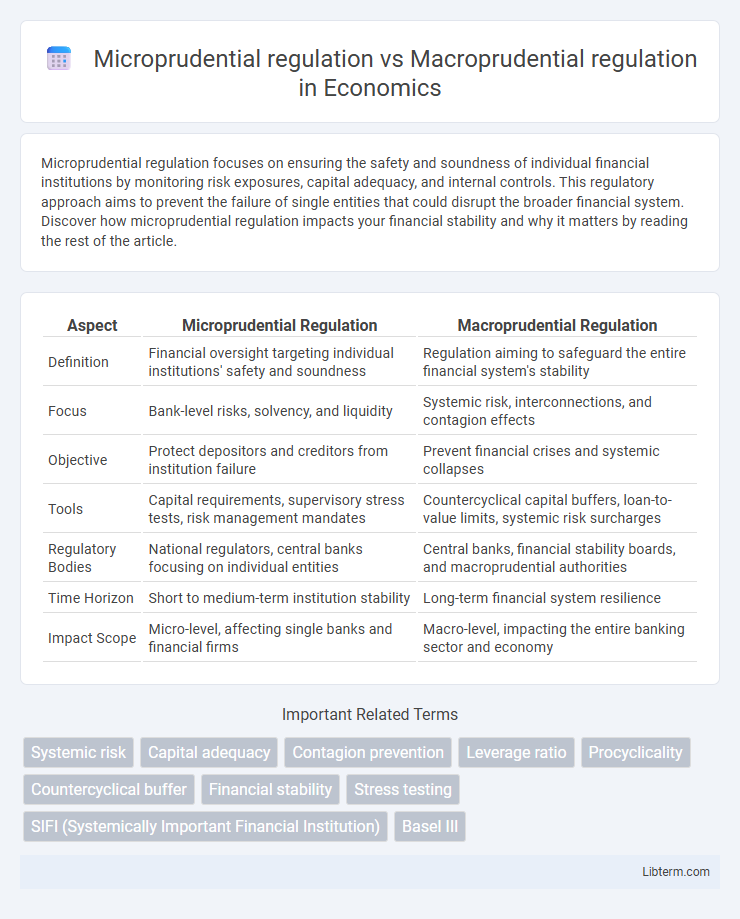Microprudential regulation focuses on ensuring the safety and soundness of individual financial institutions by monitoring risk exposures, capital adequacy, and internal controls. This regulatory approach aims to prevent the failure of single entities that could disrupt the broader financial system. Discover how microprudential regulation impacts your financial stability and why it matters by reading the rest of the article.
Table of Comparison
| Aspect | Microprudential Regulation | Macroprudential Regulation |
|---|---|---|
| Definition | Financial oversight targeting individual institutions' safety and soundness | Regulation aiming to safeguard the entire financial system's stability |
| Focus | Bank-level risks, solvency, and liquidity | Systemic risk, interconnections, and contagion effects |
| Objective | Protect depositors and creditors from institution failure | Prevent financial crises and systemic collapses |
| Tools | Capital requirements, supervisory stress tests, risk management mandates | Countercyclical capital buffers, loan-to-value limits, systemic risk surcharges |
| Regulatory Bodies | National regulators, central banks focusing on individual entities | Central banks, financial stability boards, and macroprudential authorities |
| Time Horizon | Short to medium-term institution stability | Long-term financial system resilience |
| Impact Scope | Micro-level, affecting single banks and financial firms | Macro-level, impacting the entire banking sector and economy |
Introduction to Prudential Regulation
Microprudential regulation targets the safety and soundness of individual financial institutions by enforcing capital adequacy, risk management, and supervisory standards. Macroprudential regulation focuses on maintaining financial system stability by addressing systemic risks, interconnectedness, and market-wide shocks. Both frameworks complement each other to prevent financial crises and promote sustainable economic growth.
Defining Microprudential Regulation
Microprudential regulation focuses on ensuring the soundness and stability of individual financial institutions by monitoring their risk exposures, capital adequacy, and internal controls. It aims to protect depositors and maintain confidence in the financial system through oversight of banks, insurance companies, and other financial intermediaries. Key regulatory frameworks include Basel III for banks, which sets minimum capital requirements and risk management standards.
Defining Macroprudential Regulation
Macroprudential regulation aims to safeguard the stability of the entire financial system by addressing systemic risks that affect multiple institutions and markets simultaneously. Unlike microprudential regulation, which focuses on the soundness of individual financial entities, macroprudential policy implements tools such as countercyclical capital buffers, stress testing, and leverage ratios to mitigate widespread financial crises. Central banks and regulatory authorities use macroprudential regulation to monitor interconnectedness, market contagion, and procyclicality to prevent systemic failures and promote economic resilience.
Key Objectives of Microprudential Regulation
Microprudential regulation primarily aims to ensure the safety and soundness of individual financial institutions by monitoring their capital adequacy, risk management practices, and liquidity positions. Key objectives include protecting depositors' funds, maintaining market discipline, and preventing institution-specific failures that could trigger contagion. This regulatory approach focuses on minimizing the risk of insolvency within banks and other financial entities to promote stability in the overall financial system.
Key Objectives of Macroprudential Regulation
Macroprudential regulation aims to safeguard the stability of the entire financial system by monitoring systemic risks, reducing financial sector vulnerabilities, and preventing the buildup of asset bubbles and interconnected risks. It focuses on mitigating pro-cyclicality, containing systemic contagion, and enhancing resilience to economic shocks. Key objectives include ensuring financial institutions collectively withstand crises and protecting the broader economy from widespread disruptions.
Differences Between Microprudential and Macroprudential Approaches
Microprudential regulation focuses on the stability and soundness of individual financial institutions by monitoring risks such as credit, market, and operational risks to prevent their failure. Macroprudential regulation addresses the stability of the entire financial system by mitigating systemic risks and interconnectedness that could trigger widespread crises. While microprudential measures use tools like capital adequacy ratios and stress testing at the institution level, macroprudential policies employ countercyclical capital buffers and leverage limits to manage systemic vulnerabilities.
Tools and Instruments of Microprudential Regulation
Microprudential regulation employs tools such as capital adequacy requirements, liquidity requirements, and stress testing to ensure the stability and solvency of individual financial institutions. Instruments include risk-based capital ratios mandated by frameworks like Basel III, supervisory review processes, and detailed on-site inspections. These tools collectively aim to minimize institution-specific risks, preventing failure and protecting depositors within the financial system.
Tools and Instruments of Macroprudential Regulation
Macroprudential regulation employs a diverse set of tools such as countercyclical capital buffers, sectoral capital requirements, and loan-to-value (LTV) ratio limits to mitigate systemic financial risks and enhance the resilience of the financial system. Instruments including stress testing, dynamic provisioning, and leverage ratio caps are designed to address interconnectedness and procyclicality within the banking sector. These tools differ from microprudential measures by focusing on aggregate stability rather than the soundness of individual financial institutions.
Complementarity and Interaction Between the Two Frameworks
Microprudential regulation targets the stability of individual financial institutions by enforcing capital requirements and risk management practices, while macroprudential regulation addresses systemic risks by monitoring interconnectedness and market-wide vulnerabilities. The complementarity between these frameworks is crucial as effective microprudential oversight prevents institution-level failures that can escalate into systemic crises, whereas macroprudential policies enhance the resilience of the financial system as a whole through countercyclical capital buffers and stress testing. Their interaction enables regulators to mitigate both idiosyncratic and systemic risks, fostering a more robust financial environment and reducing the likelihood of widespread financial instability.
Challenges and Future Directions in Prudential Regulation
Microprudential regulation focuses on the stability of individual financial institutions, facing challenges such as risk measurement complexity and regulatory arbitrage. Macroprudential regulation addresses systemic risks and financial system resilience, with difficulties in identifying systemic threats and calibrating countercyclical tools. Future directions emphasize integrating micro and macroprudential frameworks, enhancing data analytics, and adopting dynamic, adaptive regulatory models to mitigate emerging financial vulnerabilities.
Microprudential regulation Infographic

 libterm.com
libterm.com